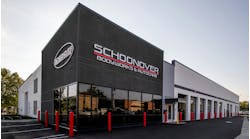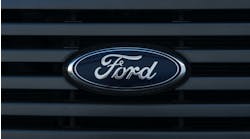Held at CREATE in the Arizona Science Center, the event showcased projects created by Phoenix’s Estrella Middle School students who participated in a unique, 12-week after-school program called “CREATE U/TechForce Foundation Transportation Challenge.”
The concept for the challenge was created by Greg Settle, TechForce Director of National Initiatives and Tim Dwyer, Education Specialist at ConsuLab Educatech Inc. Under Dwyer’s direction, industry volunteers* from the ASE Training Manager’s Council (ATMC) then built out specific “challenge scenarios” that the students were able to choose from and execute.
The goal was to help students solve real-world technical challenges that have been faced in the transportation industry. The challenge concluded with students demonstrating their projects to their parents and a number of special guests from the community and the transportation industry.
“If we’re going to solve the qualified technician shortage problem, we need to work at the grassroots level offering tangible and relevant experiences to adolescents as they start to think about their careers,” said Jennifer Maher, CEO/executive director of TechForce and speaker at the event. “The Transportation Challenge had students working in teams learning real-life tasks — from lessons on structural engineering and material compatibility to the chemistry of atmospheric air and how it affects an engine — that usually are not offered in a traditional classroom.”
Leading up to the event, three student teams utilized their STEM skills by spending two-hours each week at CREATE at the Arizona Science Center where they had access to CNC machines, laser cutters, 3D printers and an entire woodworking shop to bring their transportation prototype to life. Industry experts served as coaches to provide real-world insight and training to the students.
Each team chose a challenge out of the five created by the ATMC task force. One team was challenged with a crash test in which the team was tasked with engineering a two-axle vehicle that would protect an egg in the event of a frontal impact. Next, a team was challenged with engineering a working turbocharger for the compression of intake air into an internal combustion engine. Finally, a team was challenged with building a planetary gear set utilizing a fixed speed electric motor that would move a fixed weight a certain distance.
“This [Transportation Challenge] program not only gives youth opportunities to invent, design, and fabricate materials for actual use, but opens their eyes to the opportunities they may have in the workforce beyond going to college,” said Chevy Humphrey, the Hazel A. Hare President and CEO of the Arizona Science Center. “Every child has a path and for some, college isn’t the best fit. But when presented an opportunity to gain a high level of training to become a mobility technician and fill much needed workforce positions, our youth see alternate ways to become successful and utilize their talents and passion.”
The Transportation Challenge program was underwritten by General Motors, Nissan North America, Advance Auto Parts, Snap-on and Universal Technical Institute. It will continue at CREATE at the Arizona Science Center in 2018 with new teams and new projects to be announced at a later date.


